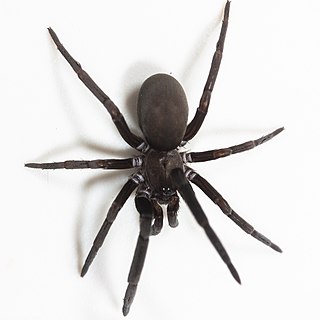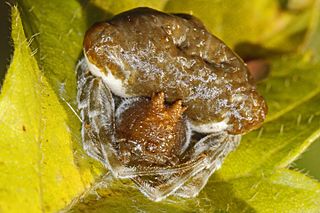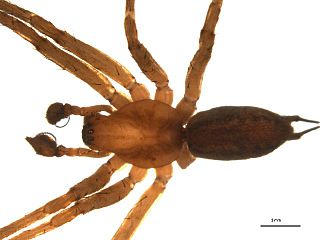
Agelenopsis, commonly known as the American grass spiders, is a genus of funnel weavers first described by C.G. Giebel in 1869. They weave sheet webs that have a funnel shelter on one edge. The web is not sticky, but these spiders make up for that shortcoming by running very rapidly. The larger specimens can grow to about 19 mm in body length. They may be recognized by the arrangement of their eight eyes into three rows. The top row has two eyes, the middle row has four eyes, and the bottom row has two eyes. They have two prominent hind spinnerets, somewhat indistinct bands on their legs, and two dark bands running down either side of the cephalothorax.

Crevice weaver spiders (Filistatidae) comprise cribellate spiders with features that have been regarded as "primitive" for araneomorph spiders. They are weavers of funnel or tube webs. The family contains 18 genera and more than 120 described species worldwide.

The southern house spider is a species of large spider in the family Filistatidae. Currently given the scientific name Kukulcania hibernalis, it was formerly known as Filistata hibernalis. Found in the Americas, it exhibits strong sexual dimorphism. It is occurs in the southern states of the USA, throughout Central America and some of the Caribbean, to southern Brazil, Uruguay and Argentina. The males may be mistaken for brown recluses because the two have similar coloration and body structure. However, compared to the brown recluse, male southern house spiders are typically larger in size, lack the distinctive violin shape on their cephalothorax, and have unusually long slender pedipalps. The females are dark brown or black and more compact. Both sexes may grow to be roughly 2 inches (5.1 cm) across, with the males typically having longer legs, and the females often having larger, bulbous bodies. The abdomen of the southern house spider is covered with fine velvety light gray hair.
The name house spider is a generic term for different spiders commonly found around human dwellings, and may refer to:

Kukulcania is a genus of crevice weavers that was first described by Pekka T. Lehtinen in 1967. It is named after Kukulkan, a Mesoamerican serpent deity.

The anatomy of spiders includes many characteristics shared with other arachnids. These characteristics include bodies divided into two tagmata, eight jointed legs, no wings or antennae, the presence of chelicerae and pedipalps, simple eyes, and an exoskeleton, which is periodically shed.
Kukulcania arizonica, commonly called the Arizona black hole spider is a species of spider belonging to the family Filistatidae. As the scientific and common names suggest, this spider is found in Arizona, United States and the neighboring states of New Mexico, Nevada and California.
Kukulcania hurca is a species of crevice weaver in the spider family Filistatidae. It is found in the United States.
Clubiona kastoni, the kaston sac spider, is a species of sac spider in the family Clubionidae. It is found in the United States and Canada.

Trachelas tranquillus, the broad-faced sac spider, is a species of true spider in the family Trachelidae. It is found in the United States and Canada.
Neoscona utahana is a species of orb weaver in the spider family Araneidae. It is found in the United States and Mexico.

Kukulcania geophila is a species of crevice weaver in the family of spiders known as Filistatidae. It is found in the United States and Mexico.

Philodromus marxi, the metallic crab spider, is a species of running crab spider in the family Philodromidae. It is found in the United States.

Mastophora phrynosoma is a species of orb weaver in the spider family Araneidae. It is found in the United States. Like all known species of the genus Mastophora, adult females are bolas spiders, capturing their prey with one or more sticky drops at the end of a single line of silk rather than in a web. Males and juvenile females capture their prey directly with their legs.
Pocadicnemis pumila is a species of dwarf spider in the family Linyphiidae. It is found in North America, Europe, Turkey, Caucasus, a range from Russia, and Japan.

Agelenopsis utahana is a species of funnel weaver in the spider family Agelenidae. It is found in the United States and Canada.

Scytodes fusca, the brown spitting spider, is a species of spitting spider in the family Scytodidae. It is found in Central and Southern America, has been introduced into Europe, tropical Africa, Seychelles, Myanmar, China, Japan, and Hawaii.
Phidippus comatus is a species of jumping spider in the family Salticidae. It is found in North America.









